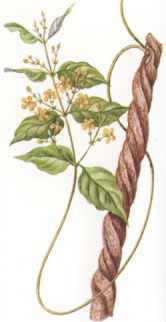
|
|
| Teltrapteris methystica - Caapi-pinima - Malpighiaceae - Tropical zones of South America, Mexico, West Indies |
|
ANOTHER KIND OF CAAPI is prepared from Tetrapteris methistica, a forest vine also belonging to the family Malpighioceae. One group of Maku Indians of the northwesternmost part of the Brazilian Amazon prepares a cold-water drink from the bark. There is no other plant ingredient. The drink is very bitter and has an unusual yellow hue. This may be the " second kind" of caapi mentioned by several explorers as caapi-pinima, meaning "painted caapi." Although T. methystica produces effects identical with those of Banisteriopsis caapi, we still know nothing of its chemistry. However, it is closely related to Banisteriopsis and there is every probability that similar or identical alkaloids are present. There are 90 species of Tetrapteris - vines and small trees found throughout the humid American tropics. |
|
Related
Articles :
|
|
| Email
This Article To A Friend - Print
This Article Articles can be E-mailed to a friend and you can get a printable version of the article IMPORTANT: We provide all information for educational purposes only, and endorse or recommend nothing here. A special thanks to Keith for all his support and insight. |
|
